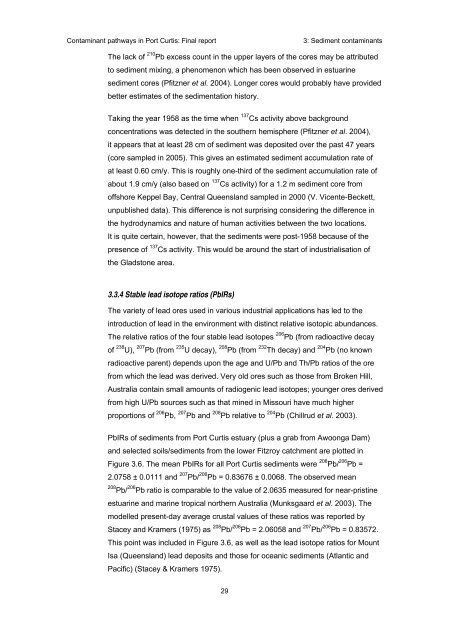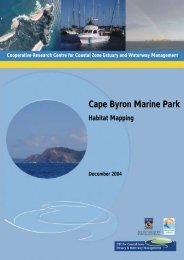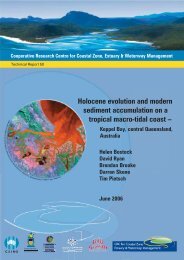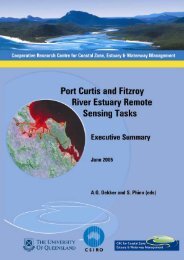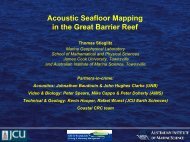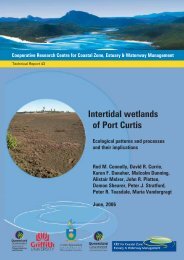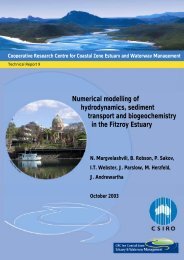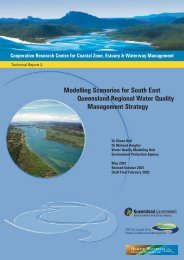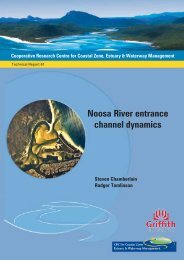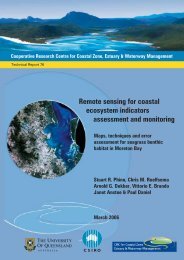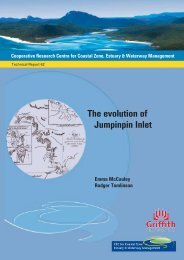Contaminant pathways in Port Curtis: Final report - OzCoasts
Contaminant pathways in Port Curtis: Final report - OzCoasts
Contaminant pathways in Port Curtis: Final report - OzCoasts
Create successful ePaper yourself
Turn your PDF publications into a flip-book with our unique Google optimized e-Paper software.
<strong>Contam<strong>in</strong>ant</strong> <strong>pathways</strong> <strong>in</strong> <strong>Port</strong> <strong>Curtis</strong>: F<strong>in</strong>al <strong>report</strong>3: Sediment contam<strong>in</strong>antsThe lack of 210 Pb excess count <strong>in</strong> the upper layers of the cores may be attributedto sediment mix<strong>in</strong>g, a phenomenon which has been observed <strong>in</strong> estuar<strong>in</strong>esediment cores (Pfitzner et al. 2004). Longer cores would probably have providedbetter estimates of the sedimentation history.Tak<strong>in</strong>g the year 1958 as the time when 137 Cs activity above backgroundconcentrations was detected <strong>in</strong> the southern hemisphere (Pfitzner et al. 2004),it appears that at least 28 cm of sediment was deposited over the past 47 years(core sampled <strong>in</strong> 2005). This gives an estimated sediment accumulation rate ofat least 0.60 cm/y. This is roughly one-third of the sediment accumulation rate ofabout 1.9 cm/y (also based on 137 Cs activity) for a 1.2 m sediment core fromoffshore Keppel Bay, Central Queensland sampled <strong>in</strong> 2000 (V. Vicente-Beckett,unpublished data). This difference is not surpris<strong>in</strong>g consider<strong>in</strong>g the difference <strong>in</strong>the hydrodynamics and nature of human activities between the two locations.It is quite certa<strong>in</strong>, however, that the sediments were post-1958 because of thepresence of 137 Cs activity. This would be around the start of <strong>in</strong>dustrialisation ofthe Gladstone area.3.3.4 Stable lead isotope ratios (PbIRs)The variety of lead ores used <strong>in</strong> various <strong>in</strong>dustrial applications has led to the<strong>in</strong>troduction of lead <strong>in</strong> the environment with dist<strong>in</strong>ct relative isotopic abundances.The relative ratios of the four stable lead isotopes 206 Pb (from radioactive decayof 238 U), 207 Pb (from 235 U decay), 208 Pb (from 232 Th decay) and 204 Pb (no knownradioactive parent) depends upon the age and U/Pb and Th/Pb ratios of the orefrom which the lead was derived. Very old ores such as those from Broken Hill,Australia conta<strong>in</strong> small amounts of radiogenic lead isotopes; younger ores derivedfrom high U/Pb sources such as that m<strong>in</strong>ed <strong>in</strong> Missouri have much higherproportions of 206 Pb, 207 Pb and 208 Pb relative to 204 Pb (Chillrud et al. 2003).PbIRs of sediments from <strong>Port</strong> <strong>Curtis</strong> estuary (plus a grab from Awoonga Dam)and selected soils/sediments from the lower Fitzroy catchment are plotted <strong>in</strong>Figure 3.6. The mean PbIRs for all <strong>Port</strong> <strong>Curtis</strong> sediments were 208 Pb/ 206 Pb =2.0758 ± 0.0111 and 207 Pb/ 206 Pb = 0.83676 ± 0.0068. The observed mean208 Pb/ 206 Pb ratio is comparable to the value of 2.0635 measured for near-prist<strong>in</strong>eestuar<strong>in</strong>e and mar<strong>in</strong>e tropical northern Australia (Munksgaard et al. 2003). Themodelled present-day average crustal values of these ratios was <strong>report</strong>ed byStacey and Kramers (1975) as 208 Pb/ 206 Pb = 2.06058 and 207 Pb/ 206 Pb = 0.83572.This po<strong>in</strong>t was <strong>in</strong>cluded <strong>in</strong> Figure 3.6, as well as the lead isotope ratios for MountIsa (Queensland) lead deposits and those for oceanic sediments (Atlantic andPacific) (Stacey & Kramers 1975).29


